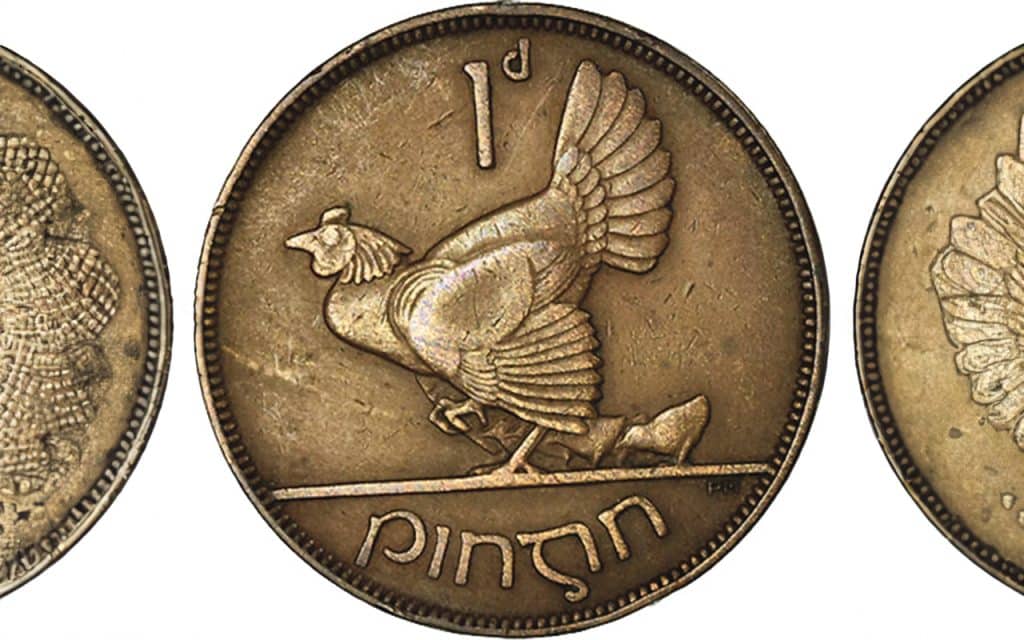
Growing up in rural West Cork in the fifties, practically every housewife kept a flock of hens. Domestic hens are direct descendants of wild Red Junglefowl (Gallus gallus) and grey Junglefowl (Gallus sonneratti) from southern Asia. These domesticated birds have spread to every corner of the earth. There are hundreds of varieties worldwide, ranging from black to white, and every colour in between. My mother usually had a flock of Rhode Island Reds and White Leghorns; they pecked around the yard and haggard adjoining the house all day. When released from the hen-house in the morning, they were fed with meal. They were always joined by chirping sparrows who pecked some of the meal. Cocks are larger and have more vivid colouring on tail and head feathers. Females can be called hens, biddies or partlets while males are cocks, roosters or stags. In Irish, a hen is ‘cearc clóis’ (yard-hen), a chicken is ‘sicín’ and the cock is the ‘coileach’. A hen and chicks appeared on the old Irish penny coin (1928-1969)
Up to the early 20th century chickens were brought into the warm kitchen at night. Some of the old kitchen dressers had a hen coop at the bottom. There was usually a perch for the cock on the wall. In later years hens had their own houses, ‘cró na gcearc’. A hen’s main contribution was her eggs, even though some hens ended in the pot for the Sunday dinner. The small feathers were used for pillows and mattresses. The symbol of St. Peter, roosters were considered protectors of humankind. Their crowing was believed to keep ‘púcaí’ (spirits) and fairies away at night. A March Cock (‘Coileach Márta’) was a cock that hatched in March from a cock and hen also hatched in March. A cock crowing at midnight presaged the death of someone close. A rooster crowing near the threshold or entering the house was an omen that visitors would arrive. The old Irish saying ‘God between us and all harm’ was always said on hearing the crow of a rooster particularly at night.
There are a number of Irish phrases for ‘cock-a-doodle doo’, particularly ‘Mac na hÓighe Slán’ (the son of the Virgin is well), which is derived from a story about two people who were discussing the resurrection of Christ while waiting for a cock in a pot to boil. One said, ‘tis more likely that this cock will rise out of the pot than a dead man could rise from the dead’. With that the cock jumped out of the pot with the words, ‘Mac na hÓighe Slán’.
There was a widely held belief in Ireland, as well as most of Europe, that St. Martin had been betrayed by either a flock of geese or a black cock. In revenge, on the eve of St. Martin’s Day (November 11), the blood of a goose, black cock or white hen was splashed on the threshold and the walls of the dwelling house.
Eggs laid on Good Friday were considered blessed and those, marked with crosses, were cooked for breakfast. Egg shells were regarded as being the dwelling places of witches and fairies, so they were always crushed when the egg was eaten. The management of fowl, milk and butter was always the job of the housewife. Each week she sold eggs and homemade butter at the local shop or market. The money raised was used to buy the weekly household goods. There are many similes and proverbs for cocks and hens, for example ‘chomh caoch le cearc san oíche’ (as blind as a hen at night); ‘chomh glórach le cearc goir’ (as loud as a broody hen); ‘chomh salach le teach na gcearc’ (as dirty as a hen house).
Of the many proverbs about hens, here are a few: As the old cock crows, the young cock learns; curses like chickens come home to roost – curses fall on the head of the curser as chickens which stray during the day return to their roost at night. ‘An chearch a dhíol lá na baistí’ (to sell the hen on a rainy day i.e. to pick the worst time to do something. ‘Is olc an chearc ná scríobfaidh di féin’ (it’s a poor hen which will not provide for herself). ‘Is minic ubh mór ag cearc bheag’ (a small hen often lays a large egg). ‘Ná comhair do chuid sicíní nó go dtaga siad amach’ (do not count your chickens before they are hatched.
A white cock in the yard was believed to be very lucky. However, if a cock crossed through the door or window of a house, this presaged a death in the family. A sop of hay or straw hanging from a hen’s tail was a sign of a funeral, while a sop across her back implied that someone in the family would die in the near future and the coffin would be shouldered to the graveyard. These were just some of the many superstitions about the cock and the hen at a time when large flocks of hens were a familiar sight in farmyards in rural Ireland. ‘God send us good luck’, was what people said when they heard a cock crow in the morning. ‘God between us and all harm’, was what they said when the cock crowed at night, which was considered very unlucky. When eggs were placed in a nest for hatching, they might be sprinkled with holy water or marked with ashes from a branch or palm, which had been blessed on Palm Sunday and which had been burned with a blessed candle. Egg shells generally were held to be the dwelling place of fairies, which was why they were always crushed when the egg was eaten.
There were many old sayings about the hen, one of the most popular being; ‘a whistling woman and a crowing hen; there is no luck in the house they’re in’. Another warned against the temptation of avarice; ‘eating and complaining like the greedy hen’. It was also said that it was a bad bird that dirtied her own nest and a bad bird that wouldn’t scratch for herself. The notion that wisdom comes with old age is encapsulated in the saying: ‘the old bird is not caught with chaff’, while caution was advised in the proverb: ‘Don’t count your chickens before they are hatched’. Curses were commonplace too and a well-known example was: ‘Six eggs to you and a half a dozen of them rotten’.
If neighbours had a falling out, one of the best ways of bringing bad luck on them was by burying rotten eggs in their property. If, however, you had the misfortune to find eggs buried in your own land, the antidote for the curse was to toss the eggs behind the fire and allow them to burn slowly. The black hen was smarter than the white hen. Why? The black hen could lay a white egg but the white hen could not lay a black egg.
There were many old sayings too about the farmyard cock. One of the most popular cautioned against vanity: ‘Every cock crows on his own dunghill’. If the cock crowed at unusual times, especially at night, then the death of a relative or family member would occur in the near future. However, when the cock crowed in the morning the people of the ‘sidhe’ (fairies) ceased their wanderings and returned to their forts or fairy mounds. Long ago many people kept a ‘March cock’ (born in March) as they thought they would keep away the fairies. The cock also figured in a curse. ‘Íde choiligh Éamoinn ort’ (the curse of Eamon’s cock on you). This was based on the sad tale of the vain cock who studied his reflection in a well for so long that he eventually fell into it and drowned.
The fox is generally portrayed as a crafty animal but in one folktale he was outwitted by the cock. Once upon a time the fox snatched the cock from the hen house. A fine fat cock that would fill the pot. When he came to the door of his den, the fox laid down the fox to kill him. He took a firm grip about the nape of the cock’s neck and pressed one of his front legs down on the cock’s back so that the poor cock was in a bad way. The fox was just about to bite his victim’s head off when the cock spoke. ‘Now Mr. Fox’ he said ‘you should be grateful to God that you have me to eat and you should give thanks to Him from the bottom of your heart before you set about eating me’. ‘That was a holy and wholesome thought indeed,’ said the fox.
The cock, however, did not know how to give thanks and told the cock, ‘Let that not be your excuse from this time onwards’ said the cock. ‘I will be happy to teach you if you wish.’ ‘I would think it a great kindness if you will, said the unsuspecting fox.’ ‘Very well, clasp your two front paws together like this – look,’ said the cock, demonstrating the correct method to the fox and lift your eyes to heaven
He loosened his grasp on the cock, then clasped his two front paws together and averted his gaze towards Heaven. No sooner had he done so than off with the cock at the rate of a mile a minute. When the fox had looked up for a long time and had heard no further instructions, he turned round but the cock was gone. ‘My thousand curses on anyone who gives thanks before he had it inside his belly,’ he cried in frustration, for he knew he had been outwitted by the wily cock.



